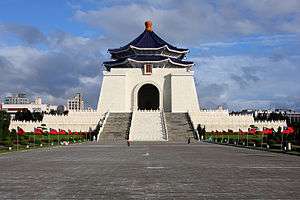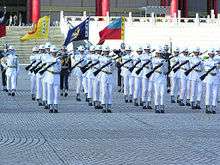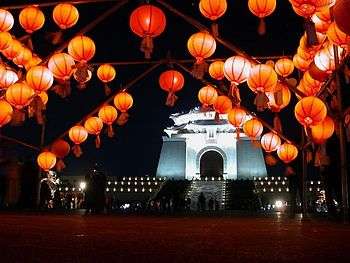Chiang Kai-shek Memorial Hall
| 中正紀念堂 | |
 | |
| Coordinates | Coordinates: 25°2′4″N 121°31′18″E / 25.03444°N 121.52167°E |
|---|---|
| Location | Zhongzheng, Taipei, Taiwan |
| Designer | Yang Cho-cheng |
| Type | Memorial |
| Material | Concrete and marble |
| Height | 76 m (249 ft) |
| Beginning date | October 31, 1976 |
| Completion date | April 5, 1980 |
| Dedicated to | Chiang Kai-shek |
| Wei-fan Kuo, Chairman of the National Chiang Kai-shek Cultural Center | |
| National Chiang Kai-Shek Memorial Hall | |||||||||||||||
| Traditional Chinese | 中正紀念堂 | ||||||||||||||
|---|---|---|---|---|---|---|---|---|---|---|---|---|---|---|---|
| Simplified Chinese | 中正纪念堂 | ||||||||||||||
| |||||||||||||||
The National Chiang Kai-shek Memorial Hall (Chinese: 中正紀念堂) is a national monument, landmark and tourist attraction erected in memory of Chiang Kai-shek, former President of the Republic of China. It is located in Zhongzheng District, Taipei, Taiwan.
The monument, surrounded by a park, stands at the east end of Liberty Square. The structure is framed on the north and south by the National Theater and National Concert Hall.
Description
The Memorial Hall is white with four sides. The roof is blue and octagonal, a shape that picks up the symbolism of the number eight, a number traditionally associated in Asia with abundance and good fortune. Two sets of white stairs, each with 89 steps to represent Chiang's age at the time of his death, lead to the main entrance. The ground level of the memorial houses a library and museum documenting Chiang Kai-shek's life and career and exhibits related to Republic of China-era Chinese history, and Taiwan's history and development. The upper level contains the main hall, in which a large statue of Chiang Kai-shek is located, and where a guard mounting ceremony takes place in regular intervals.
Development


After President Chiang Kai-shek died on 5 April 1975, the Executive branch of the government established a Funeral Committee to build a memorial. The design, by architect Yang Cho-cheng, was chosen in a competition. Yang's design incorporated many elements of traditional Chinese architecture recalling the Sun Yat-sen Mausoleum in Nanjing, China. (The Kuomintang (KMT) revered Dr. Sun as founder of the party and government Chiang had led.) Groundbreaking for the memorial took place on 31 October 1976, the 90th anniversary of Chiang's birth. The hall officially opened on 5 April 1980, the fifth anniversary of the leader's death.
Yang's design placed the main building at the east end of the Chiang Kai-shek Memorial Park (中正紀念公園), covering over 240,000 square metres in Zhongzheng District. A main gate, the Gate of Great Centrality and Perfect Uprightness (大中至正) was placed at the west end on Chung Shan South Road, with a Gate of Great Loyalty (大忠門) standing at the north side on Hsin Yi (Xinyi) Road and a Gate of Great Piety (大孝門) standing at the south side on Ai Kuo (Aiguo) East Road. A Boulevard of Homage, bordered by manicured bushes, connected the main hall with the square.
Subsequent history
The square became Taipei's site of choice for mass gatherings as soon as it opened. The nature of many of those gatherings gave the site new public meanings.
The hall and square became the hub of events in the 1980s and early 1990s that ushered Taiwan into its era of modern democracy. Of the many pro-democracy demonstrations that took place at the square, the most influential were the rallies of the Wild Lily student movement of 1990. The movement provided the impetus for the far-reaching political reforms of President Lee Teng-hui. These culminated in the first popular elections of national leaders in 1996.
The site's importance in the development of Taiwan's democracy led to the plaza's dedication as Liberty Square by President Chen Shui-bian in 2007.[1] Memorial Hall was also renamed in a dedication to democracy. The announcement of the new names were greeted with hostility by Kuomintang officials. The original dedication to Chiang was subsequently restored to the hall, while the name Liberty Square has been affirmed by officials on both sides of the political aisle.[2]
The Chinese inscription now over the main gate that declares the plaza as "Liberty Square" recalls the calligraphic style of Wang Xizhi in the East Jin Dynasty (see Chinese calligraphy). The style is noted for its sense of vitality, movement and freedom. The characters are placed in left-to-right sequence, following modern practice in Taiwan, rather than the right-to-left order of ancient Chinese tradition, which had been adopted at the site previously.[3] See: Liberty Square entrance of Chiang Kai-Shek Memorial Hall on YouTube

Gallery
 Aerial view of the Memorial Hall
Aerial view of the Memorial Hall- Historical view of front gate, prior to renaming
 Guard in the main chamber
Guard in the main chamber The lower level exhibition area
The lower level exhibition area Taipei Lantern Festival festivities on the square (2004)
Taipei Lantern Festival festivities on the square (2004) Gardens in the grounds of the Memorial Hall
Gardens in the grounds of the Memorial Hall The Gate of Great Piety, a side gate
The Gate of Great Piety, a side gate Door knocker on a lower level entrance
Door knocker on a lower level entrance
See also
- Chiang Kai-shek
- Cihu Presidential Burial Place
- Sun Yat-sen Memorial Hall
- Sun Yat-sen Mausoleum
- National Theater and Concert Hall
- Presidential Office Building (Taipei)
- List of museums in Taiwan
- Kuomintang
References
- ↑ Ko Shu-ling, National Democracy Hall reopens, Taipei Times, 2 January 2008.
- ↑ Flora Wang, Chiang Kai-shek plaque to return to memorial hall, Taipei Times, 22 January 2009.
- ↑ New calligraphy styles decided for Memorial Hall name plaques, The China Post, 7 December 2007.
http://www.brill.com/places-memory-modern-china
External links
| Wikimedia Commons has media related to Chiang Kai-shek Memorial Hall. |
- National Chiang Kai-shek Memorial Hall Official Website
- Australian information page: Chiang Kai-shek Memorial
- National Theater and Concert Hall official website